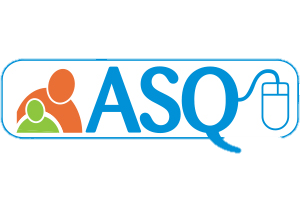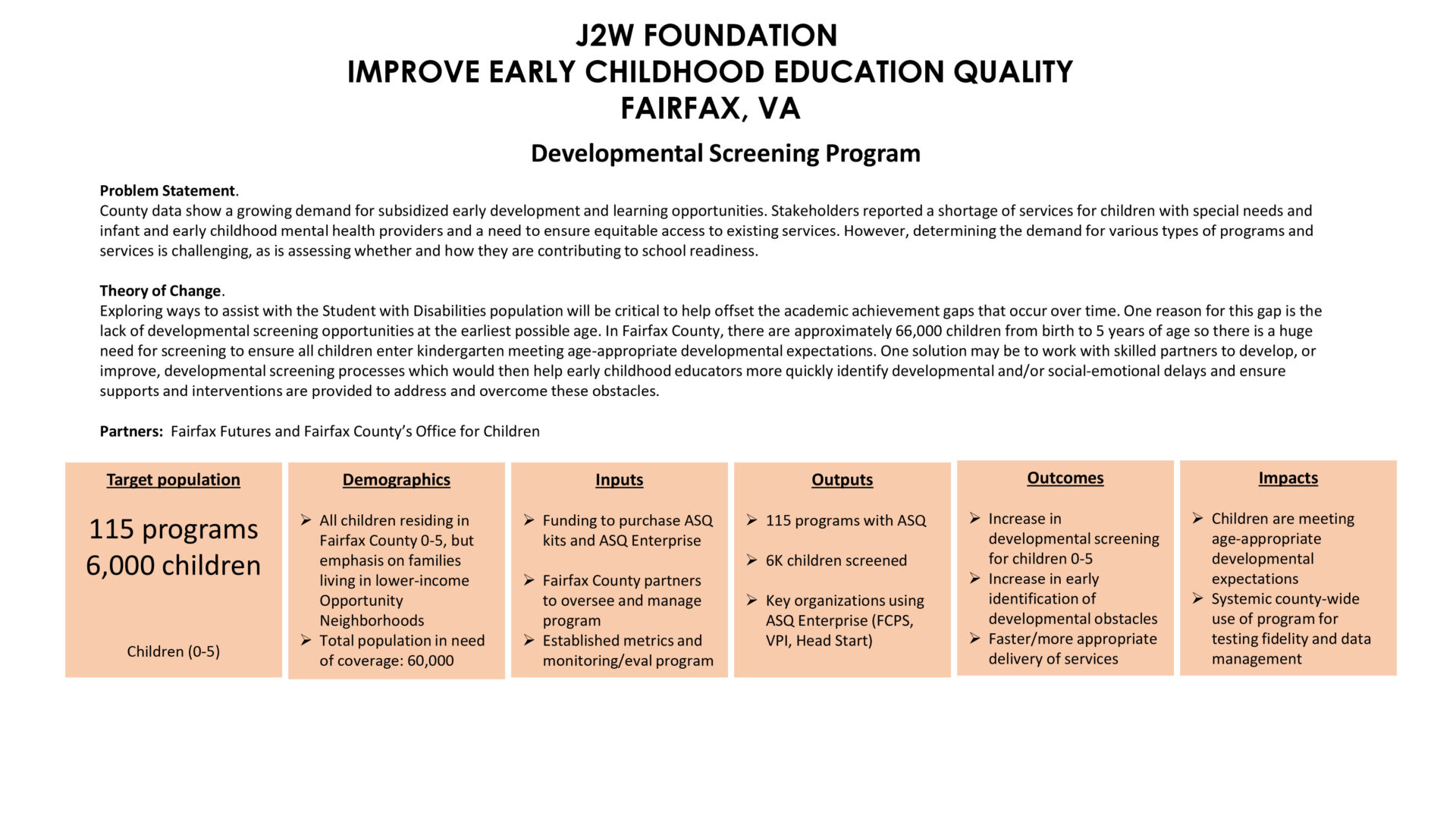ASQ Developmental Screening Programs
Promoting the Use of Developmental and Social Emotional Screeners Among Early Childhood Programs to Support School Readiness with the Ages and Stages Questionnaire (ASQ) and ASQ Social-Emotional tool (ASQ:SE)
- Developing a multi-year program designed to improve the quality of early childhood education in Fairfax County, VA set to begin in 2021, running through 2023
- Partnering with Fairfax Futures and Fairfax County’s Office For Children
- Purchasing ASQ-3 and ASQ:SE-2 kits for early childhood care providers to train educators virtually, to increase fidelity of testing, and to ultimately test more children in the county from birth to 5; and to build out the ASQ Enterprise system throughout the county to better manage data in a more systemic way
- Program is directly linked to the Fairfax County Equitable School Readiness Strategic Plan and to the J2W Foundation Strategic Plan IMPACT.2023



Measures of Performance
For more information, please see Data Analysis section at the bottom of the page
End of Program
Data Analysis
- Goal: To expand the use of the ASQ developmental screening tool among early childcare providers and caregivers across Fairfax County, VA.
- The ASQ training program was implemented by the Fairfax County-based Fairfax Futures non-profit organization, in partnership with Fairfax County’s ECPS (Early Childhood Programs and Services).
- Closing out its third and final year, the program measured several output indicators:
- The end-of-program, 3rd year cumulative target was to train 350 educators, with a mix of both home-based and center-based participants. By the end of this third year, Fairfax Futures was able to train 355 educators in the use of the ASQ-3 and the ASQ:SE-2, exceeding this goal, and thus earning a “green” health score.
- The 3rd year target, to ensure a strong focus on lower-income communities within Fairfax County, was to attempt to target Opportunity Neighborhoods (ONs). Thus, our goal was to identify and train at least 51% of educators from ONs. While the program did prioritize ONs, we ended the program with having only 39% of all educators coming from ONs. While we did not achieve our target and thus scored a “yellow”, 39% was the highest we achieved over the 3 years. The program averaged mid-30% over the 3 years.
- The third-year cumulative target was to enroll at least 65 educators with the ASQ online Enterprise data collection system. Fairfax Futures ended the project with 71 education programs using the system, scoring a “green.”
- The third-year cumulative target was to increase the number of children screened as a result of more programs using the ASQ tool. The goal for ASQ-3 screening for year 3 was 2,000 children, with 3,952 actually screened. The goal for the ASQ:SE-2 screening for year 3 was 2,000 children, with 2,630 actually screened. Both of these metrics scored “green.”
- The third-year cumulative target for getting parents engaged with the ASQ Enterprise Family Access tool was to have 1,350 screens completed by families. We have far exceeded that goal by noting 4,717 family-completed screens, a more than 300% increase, thus earning a “green” health score.
- In assessing our outcome measurements, we analyzed three areas:
- We wanted to see an increase in, not only the number of children screened, but in the number of children identified with a developmental challenge actually being referred for services (in this case, with ITC, or Infant Toddler Connection). Our goal was to see at least 90% of all children screened and in need of services receiving those services. This is one area that proved challenging in several aspects. First, it was difficult to acquire timely data and, when data did come in, it was generally several months out of date, making responsive data-driven adjustments slow. As this initiative increased its screening efforts, the number of screens completed in the ASQ Enterprise (online tool), there is the potential that an increased burden was placed on the ITC service referral system. We anticipated that at least 90% of children referred to ITC (from both our initiative and beyond) would get screened, be eligible for services, and actually receive them. However, the project ended with 69% falling in that category. Other explanations may be that certain times of the year experience greater increases in referrals to ITC than others, so numbers may fluctuate over time. This earned a “yellow.”
- Lastly, over time, we expected to see a decrease in the overall number of children needing further services after receiving supports from ITC. Looking at the ASQ-3, we rated a 4% (goal of 10% or less) as a “green” and, with the ASQ-SE, we rated 2% (goal of 3% or less) as a “green.” Ultimately, with the increased screenings and strong Enterprise uptake, this was a welcome and very positive set of data.
- The long-term sustainability goal for the ASQ program was met. The Institute for Early Learning (IFEL), within ECPS, will absorb the ASQ Learning Course training model and the ASQ Enterprise management. In the fall 2024/winter 2025, the county will begin to draft an updated Equitable School Readiness Strategic Plan to guide early childcare work over the next 5 years. Further expansion of this work will be recommended for inclusion in this updated plan.
- Program Conclusion: Overall, this program was a tremendous success. Through the incredible work done by the Fairfax Futures team, we saw a sizable scale increase in the number of developmental screens being completed by countywide educators, an increase in the uptake of a centralized data system (ASQ Enterprise), a decrease in the overall number of children needing further services from the current screenings, and we are comfortable this initiative will continue – and hopefully grow even further – within the expansive county of Fairfax. One area of emphasis for the county team moving forward will be to further analyze and assess the referral and service support capacity to ensure as more screenings are completed there are adequate back-end resources available to meet the increased demand.

